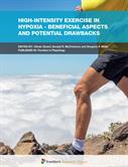Explore

High-Intensity Exercise in Hypoxia - Beneficial Aspects and Potential Drawbacks
0 Ungluers have
Faved this Work
Login to Fave
In the past, ‘traditional’ moderate-intensity continuous training (60-75% peak heart rate) was the type of physical activity most frequently recommended for both athletes and clinical populations (cf. American College of Sports Medicine guidelines). However, growing evidence indicates that high-intensity interval training (80-100% peak heart rate) could actually be associated with larger cardiorespiratory fitness and metabolic function benefits and, thereby, physical performance gains for athletes. Similarly, recent data in obese and hypertensive individuals indicate that various mechanisms – further improvement in endothelial function, reductions in sympathetic neural activity, or in arterial stiffness – might be involved in the larger cardiovascular protective effects associated with training at high exercise intensities. Concerning hypoxic training, similar trends have been observed from ‘traditional’ prolonged altitude sojourns (‘Live High Train High’ or ‘Live High Train Low’), which result in increased hemoglobin mass and blood carrying capacity. Recent innovative ‘Live Low Train High’ methods (‘Resistance Training in Hypoxia’ or ‘Repeated Sprint Training in Hypoxia’) have resulted in peripheral adaptations, such as hypertrophy or delay in muscle fatigue. Other interventions inducing peripheral hypoxia, such as vascular occlusion during endurance/resistance training or remote ischemic preconditioning (i.e. succession of ischemia/reperfusion episodes), have been proposed as methods for improving subsequent exercise performance or altitude tolerance (e.g. reduced severity of acute-mountain sickness symptoms). Postulated mechanisms behind these metabolic, neuro-humoral, hemodynamics, and systemic adaptations include stimulation of nitric oxide synthase, increase in anti-oxidant enzymes, and down-regulation of pro-inflammatory cytokines, although the amount of evidence is not yet significant enough. Improved O2 delivery/utilization conferred by hypoxic training interventions might also be effective in preventing and treating cardiovascular diseases, as well as contributing to improve exercise tolerance and health status of patients. For example, in obese subjects, combining exercise with hypoxic exposure enhances the negative energy balance, which further reduces weight and improves cardio-metabolic health. In hypertensive patients, the larger lowering of blood pressure through the endothelial nitric oxide synthase pathway and the associated compensatory vasodilation is taken to reflect the superiority of exercising in hypoxia compared to normoxia. A hypoxic stimulus, in addition to exercise at high vs. moderate intensity, has the potential to further ameliorate various aspects of the vascular function, as observed in healthy populations. This may have clinical implications for the reduction of cardiovascular risks. Key open questions are therefore of interest for patients suffering from chronic vascular or cellular hypoxia (e.g. work-rest or ischemia/reperfusion intermittent pattern; exercise intensity; hypoxic severity and exposure duration; type of hypoxia (normobaric vs. hypobaric); health risks; magnitude and maintenance of the benefits). Outside any potential beneficial effects of exercising in O2-deprived environments, there may also be long-term adverse consequences of chronic intermittent severe hypoxia. Sleep apnea syndrome, for instance, leads to oxidative stress and the production of reactive oxygen species, and ultimately systemic inflammation. Postulated pathophysiological changes associated with intermittent hypoxic exposure include alteration in baroreflex activity, increase in pulmonary arterial pressure and hematocrit, changes in heart structure and function, and an alteration in endothelial-dependent vasodilation in cerebral and muscular arteries. There is a need to explore the combination of exercising in hypoxia and association of hypertension, developmental defects, neuro-pathological and neuro-cognitive deficits, enhanced susceptibility to oxidative injury, and possibly increased myocardial and cerebral infarction in individuals sensitive to hypoxic stress. The aim of this Research Topic is to shed more light on the transcriptional, vascular, hemodynamics, neuro-humoral, and systemic consequences of training at high intensities under various hypoxic conditions.
This book is included in DOAB.
Why read this book? Have your say.
You must be logged in to comment.
Rights Information
Are you the author or publisher of this work? If so, you can claim it as yours by registering as an Unglue.it rights holder.Downloads
This work has been downloaded 238 times via unglue.it ebook links.
- 89 - mobi (CC BY) at Unglue.it.
- 72 - epub (CC BY) at Unglue.it.
- 77 - pdf (CC BY) at Unglue.it.
Keywords
- altitude training
- anaerobic metabolism
- cerebral deoxygenation
- critical power
- HIF-1?
- hypoxia
- ischemic preconditioning
- metaboreflex
- muscle activation
- muscle deoxygenation
- repeated sprint training in hypoxia
- resistance training in hypoxia
Links
DOI: 10.3389/978-2-88945-406-8Editions

